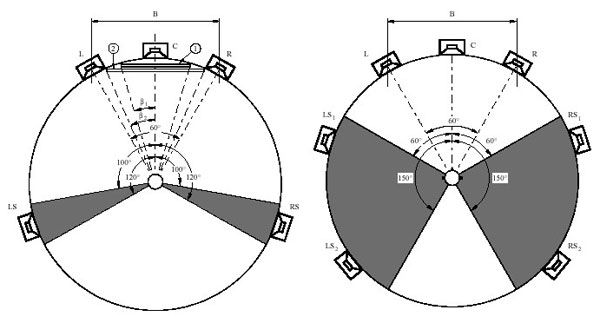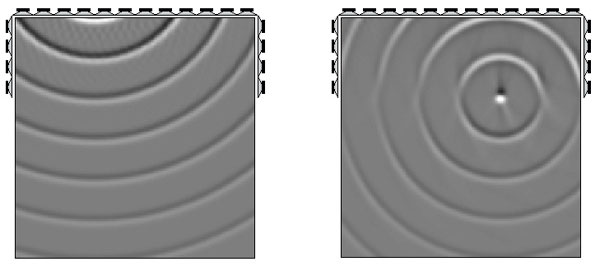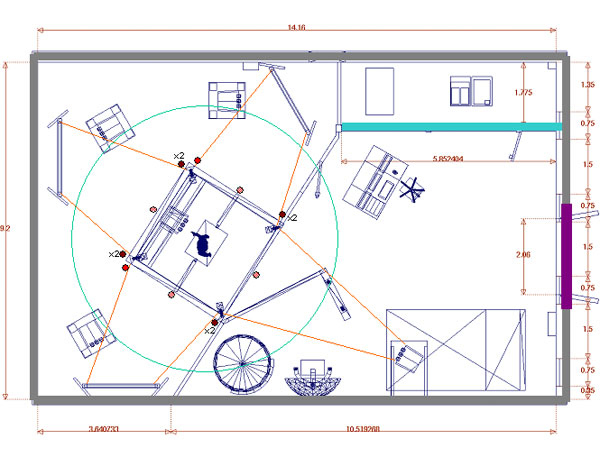| Particularly, the CAVE-like VR environments
are the ones which would most benefit from auralization
techniques, i.e., of the emulation of a three-dimensional
real sound field of a given audiovisual scene,
be it through loudspeakers or even using headphones,
so as to allow the sensation of real immersion
within the virtual environment, and guarantee
coupling of 3D visual perception with 3D auditory
perception.
Complete Immersive Virtual Reality
VR systems where the auditory experience is matched
to the visual experience are considered as complete
virtual reality ones. If the VR environment is
immersive, as occurs in the Digital
Cave where users are immersed inside a virtual
scenario and have freedom to move around, the
experience of complete (audio and video) virtual
reality is also said immersive.
Imagine yourself moving around exotic musical
instruments playing in an ancient greek arena,
or the experience of creating personal orchestras
and listen to them not from the auditorium, but
immersed in the scene, surrounding the instruments.
Virtual audiovisual experiences like this could
be explored and made feasible by means of complete
immersive VR, in environments such as the Digital
Cave.
It is desirable that the auralization system
be based on loudspeaker (multichannel) paradigm
so as to provide wider mobility and freedom for
the users, who wouldn’t need headphones.
However, the creation of three-dimensional sound
fields mathematically and/or physically correct
is a complex task, which has gained a lot attention
from the scientific community in the last years,
being currently a research field very active and
promising, specially after the considerable growth
of interest due to the popularization of the surround
systems for cinema (movies) and home-theaters,
known as 5.1.

Figure – 5.1 and 7.1 systems (standard
ITU-R BS.775)
There are several ways to develop sound spatialization
solutions or auralization for virtual reality.
Systems as a whole encompass from the design and
development of the audio infrastructure and equipment
installation, to the conception and design of
applications for navigation in the 3D environment,
the acoustic scene composition and control, and
the choice and implementation of 3D audio coding
formats, which could be also several.

Figure – Tasks Scenario
Immersive Audio Project
The on-going project for R&D of solutions
for immersive audio in the Digital Cave looks
for the implementation of a flexible and scalable
system for 3D audio reproduction. Flexible in
the sense of offering a minimum set of audio spatialization
and auralization alternatives for applications
having sound in several formats, from stereo/binaural
up to the most sophisticated 3D multichannel audio
coding under development. Scalable in the sense
of allowing the associative usage of different
formats, schemes or methods of sonorization, e.g.
altering the spatial configuration (location)
and number of loudspeakers depending on the auralization
method, or employing complementary techniques,
such as associating commercial reverb machines
to provide selected types of envelopment, or either
using different computer systems (hardware and
software).
Objectives include since the implementation of
decoding systems for the traditional formats and
surround configurations (such as 5.1, 7.1, 10.2,
DTS, THX, Dolby) up to the development and deployment
of more sophisticated formats for 3D audio generation
and reproduction, still restricted in the high-fidelity
applications and research labs, and under development.
For these formats, not only the reverb and surround
envelopment are important, but also the location
of sound objects in the 3D scene (perception of
sound directivity) and the synthesis of the acoustic
environment. In this category we include the Ambisonics
and Wave-Field Synthesis formats.
The first, already known since the 70’s
when first coder/decoder proposals showed up,
is based in an elegant mathematical formulation
where both spatial and temporal sound information
is coded into 4 vectors – x, y, z, and w
(for 1st. order Ambisonics), as if it were projected
onto cartesian axes. Initially conceived to register
a real sound field recorded by soundfield microphones,
this format can be adequately adapted to permit
the computer simulation and creation of artificial
sound fields. To reproduce the sound, the vectors
are accordingly transformed in outputs for loudspeakers
distributed in a known configuration around the
audition area. A clear advantage of this method
is in its flexibility to choose the number of
loudspeakers one wants to use, and their positions
around the audition area.

Figure – Ambisonics scheme (both sound
objects and loudspeakers
have their location in the space parameterized
by the system)
The second format (Wave Field Synthesis –
WFS) is more recent, and is based on a more computational
complex formulation involving the physical modeling
of the sound waves propagation in the environment,
and takes into consideration a discretization
of the physical space of the audition area. In
this technique the main goal is to emulate a wave
front that would be produced by real sound objects
in a specific acoustic environment, through the
usage of a densely distributed loudspeaker array
around the audition area. An advantage of this
technique is its higher tolerance to more listeners
inside the audition area and its capability to
induce the perception of sound fields located
on a larger audition area, including the possibility
of positioning objects in the middle of the area,
around or among the listeners, and formed ahead
of the loudspeakers. The wave front synthesis
is a critical task, and may implicate in a high
computational cost, which we intend to approach
using cluster computing, distributing the computational
tasks and calculus associated to the auralization
process over the nodes of a computer cluster.

Figure – Wave Field Synthesis (illustrating
a sound object formed behind the speakers, and
ahead of the speakers, inside the audition area)
The immersive audio project in the Digital Cave
considers activities addressing the development
of software and also hardware (loudspeaker arrays
and multichannel audio platforms) for the implementation
mainly of these two 3D audio formats.
General System Block Diagram
Some mechanisms and/or communication protocols
to allow control of the sound synthesis by the
VR applications will be developed and investigated,
so that applications can directly sound using
supported auralization techniques. One proposal
considers the usage of asynchronous channels to
transmit commands and/or data updates concerning
sound objects in the acoustic scene directly feeding
the processes that control synthesis and auralization.
Usability and integrated audiovisual navigation
control are fundamental issues for complete immersive
virtual reality. Synchronization, scene description
resource sharing, computational load allocation
and interaction model are vital and even critical
to obtain the final desired effect. These control
and management requirements are necessary and
considered in the whole system conception. Below,
it is shown the reference block diagram for the
implementation of an Ambisonics auralizator integrated
to a VR application.

Figure – VR Application + Ambisonics
Auralizator (block diagram)
Blocks:
- VR application (acoustic scene and 3D navigator
setup)
- inter-process communication directives and audiovisual
synchronization
- sound synthesis (wavetable and/or synthesizers)
- acoustic scene modeling (acoustical model)
- spatialization or auralization (coding in 3D
format)
- decoding (output generation for loudspeakers)
- reproduction (amplification and distribution
of audio “streams”)
Some graphical programming languages to control
synthesis and sonification processes may be used,
for example MAX/MSP or PD (Pure Data, from Miller
Puckette), as well as tools for scene description
from MPEG-4 and Web3D (as X3D), as for example
the 3D navigator Jynx,
developed in the Digital Cave.
Applicability
Auralization techniques find a huge number of
possible applications in the areas of virtual
reality, bi-directional multimedia and immersive
television, allowing the enhancement of realism
for the visual presentation or adding differential
information that is context-dependant or relevant
for the virtual environment.
Consider as an example an application design for
aeronautics engineering, where designers navigate
around an airplane model, interested in inspecting
the air flow throughout the fuselage. The noise
associated to the turbulence and different sound
intensities in several points may add relevant
acoustic information to the engineering/design
process, bringing simulated reality to the reach
of engineers.
In a insulation and internal noise control design
for planes the audiovisual navigation within the
virtual model will make possible to evaluate the
sound quality and intensity in distinct spots
around, helping to locate and assess localized
problems, failures, and optimize the design tuning.
A physically correct auralization of the sound
field would e necessary for such activities and
explorations in engineering projects.
Applications turned to enhancements or to the
conception of new multimedia services are continuously
demanding more realism and quality in the audio
and video media presentation. For some applications,
such as the development of new generations of
teleconference, videophone or interactive television,
there is an enormous interest in 3D models, which
can reconstruct a remote audiovisual reality,
which is by its turn also three-dimensional.
Systems oriented to telepresence or sophisticated
multi-user immersive teleconference already consider
the utilization of holography or stereoscopy techniques,
not only for transmitting with incremented realism,
but also addressing the production of a more fluid
or continuous visual interface linking remote
points. Joint stereoscopy and 3D auralization
allow a fusion of the remote parts in a more uniform
and gradual manner, or can transport users to
a new environment, where visual and acoustic 3D
properties may be shared.
New generations of systems for telepresence, where
capturing multiple projections is already a reality,
could also benefit of adopting a 3D audio capture,
taking into consideration the sound directional
properties. With fast networks (e.g. gigabit Ethernet),
with multichannel multimedia compression techniques
and adequate multiprojetion techniques it turns
possible to investigate the limits and exercise
creative capacity for conception of sophisticated
3D multimedia transmission and rendering.
A “soundfield” microphone coupled
to a 3D audio coder, such as Ambisonics, may be
employed to capture and transmit a 3D sound field
from a place to another remote one. Sound channels
may be properly coded and integrated to video/media
bitstreams, opening many interaction modes, conception
possibilities for new services and applications,
benefiting from the fusion of audio and video
3D.
Also in the digital television (DTV) new applications
addressing transmission and local rendering of
3D (virtual) acoustic environments are already
feasible with recent “surround”-like
systems (5.1 channels) and for some DTV standards.
However, they still consist of high cost applications
and less explored in respect of content production,
interaction and realism enhancement.
We consider as a future goal in application design
for the CAVE the prototyping of an integrated
application for capture, transmission and rendering
for both 3D audio and video, which could be ported
to complete immersive virtual reality applications,
as well as to advanced digital TV applications.
Implementation Phases
phase I : Infrastructure (Aug/2004 to Mar/2005) : [ Concluded ]
- basic infrastructure (acquisition of audio
server and multichannel soundcards; installation
of speakers, amplifiers and cabling; loudspeaker
support system; microphones and headphones)
- basic hardware/software installations (installation
of audio server, gear rack, boards and patches;
installation of basic software, drivers and
libraries; tests)
- development software installation (DSP; C/C++
compilers; software for edition, sequencing,
control and route of digital audio; patch-oriented
development platforms; multichannel setups;
graphical music programming; codecs and VST
plugins; software and libraries for management
and inter-node communication; libraries and
gear for sound synthesis and acoustics; general
apps; tests)
- acoustic setup (hw/sw integration; preliminary
tests; acoustic measurements; patch setups and
general calibration)
- acoustic treatment (acquisition/installation
of additional equipment for acoustic conditioning;
adaptations;)
phase II : Ambisonics I (Aug/2004 to July/2005) : [ Concluded ]
- research and development concerning a system
for Ambisonic coding/decoding
- development of navigators and user interfaces
integrated to VR tools in the Digital Cave
- integration design of software
components for inter-process and inter-node
communication (message/command passing, streaming,
control, synchronization)
- development and/or integration of modules
for description, simulation and rendering acoustic
scenes (acoustic model)
- specific applications (virtual acoustic environment
modeling in specific applications)
- design and first implementation of the "AUDIENCE Spatial Sound Package" for PD.

Figure – Digital Cave and loudspeaker
array for Ambisonics (preliminary design)
phase III: Higher Sound Immersion Levels (Apr/2005
to Dec/2006)
- design and development of a system for higher sound immersion levels, exploiting higher order Ambisonics and WFS coding/decoding
(partnership with other universities and/or
institutions)
- release of AUDIENCE Spatial Sound Package for PD (v.1.0)
- development of loudspeaker array systems
and multichannel reproduction systems (partnership
with companies)
- development of a WFS interactive auralization
control system (WFS auralizator) orienting to
advanced applications in virtual reality and
home-theater environments
- adaptation and improvement of acoustic models
for higher sound immersion levels.
- development and/or adaptation of multichannel
soundboards, circuitry (hardware) and software
for driving dense loudspeaker arrays
- specific applications (high coupling with
visualization and realistic audiovisual rendering;
Voyager’s holodeck is taking off!)

Figure – Digital Cave and loudspeaker
array for Wave Field Synthesis (preliminary design)
phase IV : Low cost Auralizators and Commercial
Systems (May/2006 to May/2007)
- activities concurrent with phase III
- acquisition and integration of commercial
3D/2D audiovisual codecs
- integration of surround decoders (partnership
with companies)
- research and development of mechanisms for
synchronization and control of low cost sound cards and chipsets for sound field generation applications
- proposing and prototyping low cost multichannel
auralizators
Team
| Regis
Rossi A. Faria ( PhD.EE
) |
| Associate
Researcher / R&D Manager |
phone (+55.11) 3091-5589 |
| email: regis@lsi.usp.br |
| Leandro
Ferrari Thomaz ( EE, MSc. graduating
) |
| Researcher
at the Media Engineering Center and Digital
Cave |
phone (+55.11) 3091-5589 |
| email: lfthomaz@lsi.usp.br |
| Luiz
Gustavo Berro ( EE, undergraduate
student ) |
| Trainee |
phone (+55.11) 3091-5589 |
| email: berro@lsi.usp.br |
| João
A. Zuffo ( PhD. EE ) |
| LSI-EPUSP head |
phone (+55.11) 3091-5254 |
| email: jazuffo@lsi.usp.br |
| Marcelo
K. Zuffo ( PhD. EE ) |
| Interactive Eletronic
Media Group Coordinator |
phone: (+55.11) 3091-9738 |
| email: mkzuffo@lsi.usp.br |
Project Collaborators
Prof. Dr. Sylvio
Bistafa (EP-USP, Dept. Mechanical Eng.)
Prof. Dr. Fabio
Kon (IME-USP)
Prof. José Augusto Mannis (CDMC-UNICAMP)
Dr.Eng.
Márcio Avelar Gomes (UNICAMP)
Intitutional Partners
   
|









